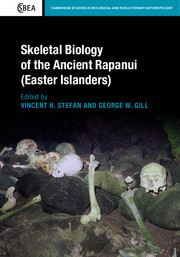Book contents
- Frontmatter
- Contents
- List of contributors
- Acknowledgements
- 1 Introduction: Research overview
- 2 Review of Polynesian and Pacific skeletal biology
- 3 Chronology and Easter Island prehistory
- 4 A descriptive skeletal biology analysis of the ancient Easter Island population
- 5 Craniometric variation of the prehistoric Polynesians and Rapanui
- 6 Rapanui non-metric cranial traits
- 7 Intra-island discrete cranial trait variation
- 8 Continuous non-metric characteristics of the early Rapanui
- 9 Rapanui dental morphology
- 10 Pelvic variability and sexual dimorphism in prehistoric Rapanui
- 11 Genetic affinities of the Rapanui
- 12 Archaeogenetics and paleodemographic estimation of founding populations: Features of residential geography on Rapa Nui
- 13 Evidence for injuries and violent death
- 14 Demographic analysis of modified crania from Rapa Nui
- 15 East Polynesian and Paleoindian parallels and contrasts in skeletal morphology
- 16 Rapanui origins, relationships, and warfare: A summary in theoretical context
- References
- Index
10 - Pelvic variability and sexual dimorphism in prehistoric Rapanui
Published online by Cambridge University Press: 05 December 2015
- Frontmatter
- Contents
- List of contributors
- Acknowledgements
- 1 Introduction: Research overview
- 2 Review of Polynesian and Pacific skeletal biology
- 3 Chronology and Easter Island prehistory
- 4 A descriptive skeletal biology analysis of the ancient Easter Island population
- 5 Craniometric variation of the prehistoric Polynesians and Rapanui
- 6 Rapanui non-metric cranial traits
- 7 Intra-island discrete cranial trait variation
- 8 Continuous non-metric characteristics of the early Rapanui
- 9 Rapanui dental morphology
- 10 Pelvic variability and sexual dimorphism in prehistoric Rapanui
- 11 Genetic affinities of the Rapanui
- 12 Archaeogenetics and paleodemographic estimation of founding populations: Features of residential geography on Rapa Nui
- 13 Evidence for injuries and violent death
- 14 Demographic analysis of modified crania from Rapa Nui
- 15 East Polynesian and Paleoindian parallels and contrasts in skeletal morphology
- 16 Rapanui origins, relationships, and warfare: A summary in theoretical context
- References
- Index
Summary
Introduction
Accurate identification of human skeletal remains is central to forensic and archaeological investigations. Methods of identification have been devised for nearly every bone in the human body and it is widely agreed that the elements of the pelvic complex offer the best indicators of sex. The present study has evolved from research aimed at quantifying morphological differences between the sexes in adult pelvic morphology (Harrison, 2003; Harrison and Harper, 2007). In Harrison's (2003) study, 20 measurements were designed and tested on an anatomical collection of known age and sex in an attempt to quantify sexually dimorphic traits of the os coxa traditionally used in qualitative methods. The result of that study was a protocol of measurements that could be used for the determination of sex in unidentified remains with an accuracy of 85–95 percent. A follow-up study utilizing the same measurements then tested for differences between Blacks and Whites of the same sample. Results showed not only marked differences between the sexes, but between populations. This chapter presents the results of a preliminary analysis of quantifying sex and population differences in pelvic morphology, utilizing measurements of the os coxae designed by Harrison (2003).
Pelvic measurements are recorded on an archaeological sample from Rapa Nui and a sample of nineteenth‐ and twentieth‐century North Americans commonly used for the development of forensic and osteological standards. The goal of this chapter is three-fold: 1. test the efficacy of standard canonical discriminant analysis to quantify sexual dimorphism using an archaeological sample, 2. test for population differences in pelvic morphology between the groups, and 3. address sexual dimorphism specific to the Rapanui. This research highlights the potential for an accurate alternative approach to the determination of sex and throws into light the question of population variability in pelvic morphology.
The human os coxae
The adult human pelvic girdle is formed by the articulation of three components, the sacrum, coccyx, and os coxae (right and left innominates/hip bones). Prior to adolescence, each os coxa consists of three unfused parts; the ilium, ischium, and pubis that join and fuse in the acetabulum by early adulthood. In articulation the female pelvic complex generally exhibits laterally flaring iliac crests, a wide heart-shaped basin, wide sciatic notch, elongated superior pubic rami, wide-angle inferior pubic rami, and a wide, rectangular pubic body.
- Type
- Chapter
- Information
- Skeletal Biology of the Ancient Rapanui (Easter Islanders) , pp. 167 - 181Publisher: Cambridge University PressPrint publication year: 2016



